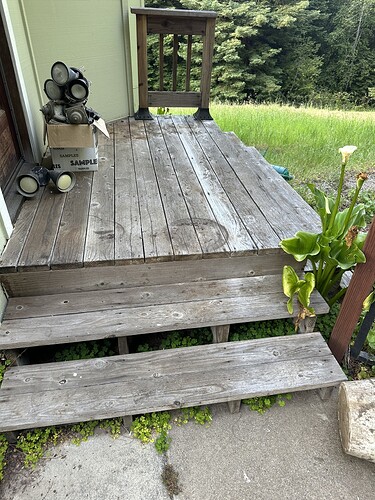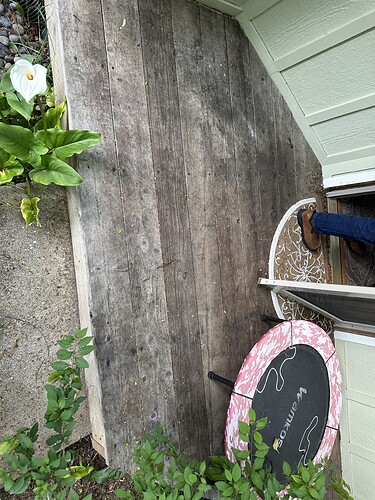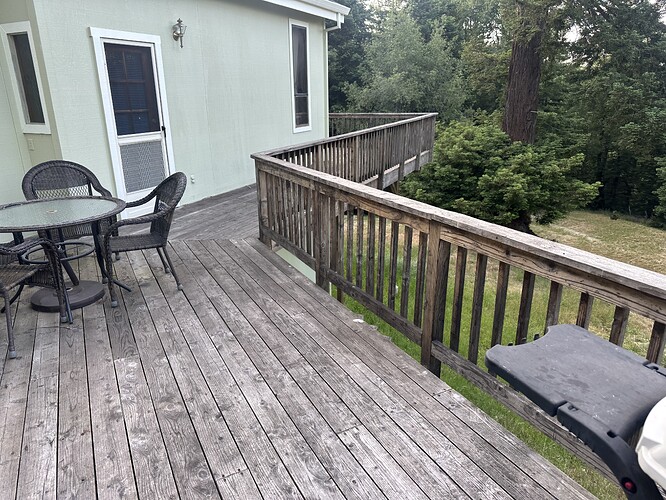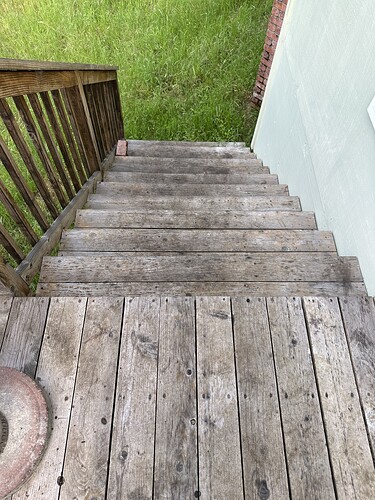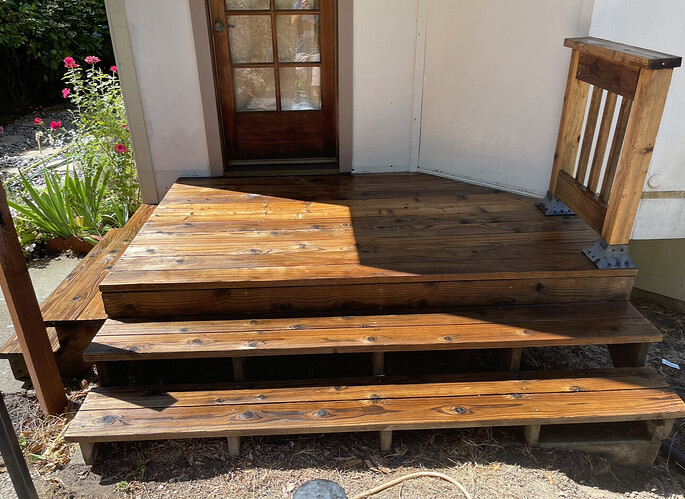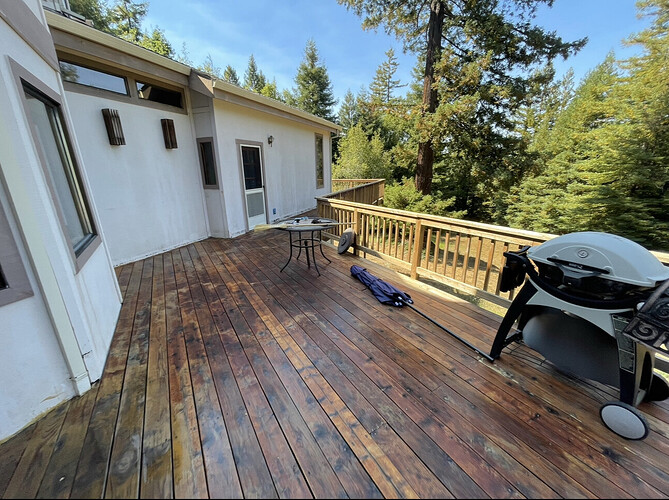So i have a customer that asked if i can strip thompsons water sealer from their deck. I dont do alot of wood work and ive never stripped thompsons before. Should i use sodium hydroxide? Is hot water going to be necessary? Thanks guys i have searched a few different forums and havent had any luck.
Fences are my primary business so this is based on my experience with them. I have had little to no luck stripping Thompson’s with chemicals (vertical surface dwell time may be a contributing factor). I have had to “blast” it off and just do my best to keep the wand moving and not cut the wood. No one walks on their fence though so that may not be an option. If the customer has used Thompson’s I now refuse the job, the stuff is just miserable to work with IMHO. Good Luck
HD-80 will take it off with ease. On a horizontal surface you’ll get a big ball of paraffin wax. I’ve done it before. Pretty good SHydroxide. Give me a call and I’ll tell you about it. David
Under Pressure of Boone
828-964-2563
Give it a year and Thompson’s water sealer will strip itself. That’s that’s awful. No longevity.
Thanks for the tip. If I run into it again and really want the job I’ll give you a call. I’m so busy right now I’m having a hard time returning quotes…not complaining just a little overwhelmed at this point. Our combination of wind and rain this spring has really got me backed up on fence staining.
If it’s horizontal to strip… HD80-Thompsons= easy $$$. Agree is a crap (film forming) product but most homeowners realize that after they fall for a good commercial.
That’s a great problem to have!
I cleaned a clients decks two years ago using Deck Restoration Plus metasilicate stripper to get rid of the old stain, then did a 1000 psi wash, followed by a citric acid treatment. They pretty shortly there after applied Thompson’s water seal over it. Now the wood is almost all gray again. Is that a sign that the seal has now failed since it gray? I’m thinking that’s the case especially since it has been two years. They don’t get a ton of sun, but there is definitely some. I’m wondering if I can just use sodium percarbonate, followed by 1000 psi rinse and citric acid treatment to get it back looking to like new wood again? Trying to avoid having to use the stripper product or the one mentioned above…
Here is what it look like when we finished it in August 2021
Thompsons is garbage, if you read the SDS you will see it is mainly water. If you stripped it they could have painted it or stained it. I prefer a penetrating stain as it will never peel, crack, or flake, but some people like paint. Oils just fade over time, so it is like a gas gauge, when it starts fading it is time to redo it. Most manufacturers like to specify some type of maintenance plan on their decks otherwise they won’t warranty a claim. Most of these things are garbage, they basically have you restain the deck every year.
Anyway, realistic expectation for a deck are 2 years horizontal and 4 years vertical if a semi transparent to solid was used. If they live in the north and put rock salt on it and beat it with shovels, 1 year with any film former.
I wouldn’t go the percarb route. Since you know they put Thompson’s on there, I’d go with the metasilicate. There are too many Thompson horror stories out there by guys trying to remove it. Ask what color if any they went with. Looks like they just put the clear on it. The clear has no UV protection and is basically gone in a year…though Thompsons seems to find a way to stick around.
I have a customer that built a new privacy fence around his McMansion and stained the inside by hand with Thompson’s. He hired me to do the outside as it was a lot of work to do by hand. I now spray it all once a year for $1200 and it takes me about three hours to do it. He supplies the stain.
Some people are just fools and as much as I try to educate them you can’t save the world. He’s a nice guy and his wife always brings cold lemonade out for us. I figured he’ll be a good customer for the next ten years or so until his fence begins to rot away because it’s never truly been protected from the elements but…c’est la vie.
Yeah, I just got some more DRP wood stripper. It makes the color real nice and it is easy to use. I charged for it, so it’s not a big deal. However, this time going to let him know that if he wants to keep the color he needs to use a stain with some pigment in it. Even if the color of the stain is the same as the wood itself. I don’t do staining, but I’ve been getting educated more on it since if I’m offering wood restoration I better know how to at least guide the customer in the direction to make it last.
I’m not familiar with that product but it seems like metasilicate would work just fine and hydroxide would be overkill.
tried drp stripper plus today on a deck that was painted. Not a fan. Maybe if it had one coat, not two to three. Plus that stuff had to be rinsed so much, way more than hydroxide and oxalic. I rinsed some boards at least 5-6 times and i was still seeing suds. That was after walking the boards to strip them.
I tried spraying it with a 1 gallon pump up, too thick came out in a stream. Wound up rolling it on. Some sections stripped great, others will need a lot of sanding. One 4x4, 2 steps, and 1 stringer look like I didn’t even try to strip them. I’ll finish using what I have then I am back to my normal.
it is some type of alcohol based product that doesn’t need neutralizing. Thought I would give it a whirl. Worked real well on another deck with Thompsons.
Mineral sprirts will take it off
You are supposed to use oxalic ( I use citric). The Metasilicate does make the color pretty, but yes I experienced the same thing with needing to have some areas sanded. DRP sells a brightener that I’m convinced is just over priced oxalic acid with maybe one other little thing in it that probably doesn’t do much. How much did you dilute the product? In my general experience, most vendors try to provide what they call value by saying that you can dilute their product way more than it should be. Sometimes you can, but a lot of times I just use stuff full strength or their least diluted amount on the instructions. I think I used it 50/50 on the tough spots
There is drp wood stripper and drp wood stripper plus. THe plus is a thick white liquid that doesn’t require neutralization. The other stuff that you are using is either metasilicate or hydroxide and you have to neutralize that. Anyway, I am going back to mixing my own. I spent too much time sanding today and couldn’t paint it because rain is going to fall in less than 14 hours. Another job on hold.
What are you using that won’t be dry in 14 hrs?
SW superdeck solid. Recommends 24 before rain. I felt like I could be okay as the deck was dry as a bone. To be safe I called the painter I PW for, because he uses their stuff a lot. I asked if it would be okay to risk it. He said he did that before and it rained and left little white spots on it. He recommended against it, so since he is that store’s number one purchaser I decided to go with his recommendation. It was overcast at the time, so no direct sun to beat on it and speed up the cure. In the end I figured why risk it after all that work stripping and sanding. I sure wouldn’t want to sand or strip again.
Having said that, I watched 3 young people paint a house today while it was raining. Homeowners probably don’t know any better.
Interesting, wonder what the difference is I should look up the SDS. This is a pretty good video where he explains the difference between the two. To be successful with today's coatings you NEED two types of strippers. - YouTube
The regular wood stripper you can dilute either 3:1 or up to 7:1. He does say that the coating remover (the plus version) you used is not to be diluted at all and that you can spray it on instead of brush. He said it can take as long as four hours for it to work. He also said that there is no hazmat in that product (so shipping is cheaper), but what was interesting to me is I would think that it would be more hazardous if it works for harder to remove coatings, which just doesn’t really make any sense to me. I’m wondering if the other stuff would’ve worked better.
I’m heading off this morning to go use the regular stripper on these four decks today. Since it has been almost 2 years, I’m going to try diluting at 7:1 at first.
